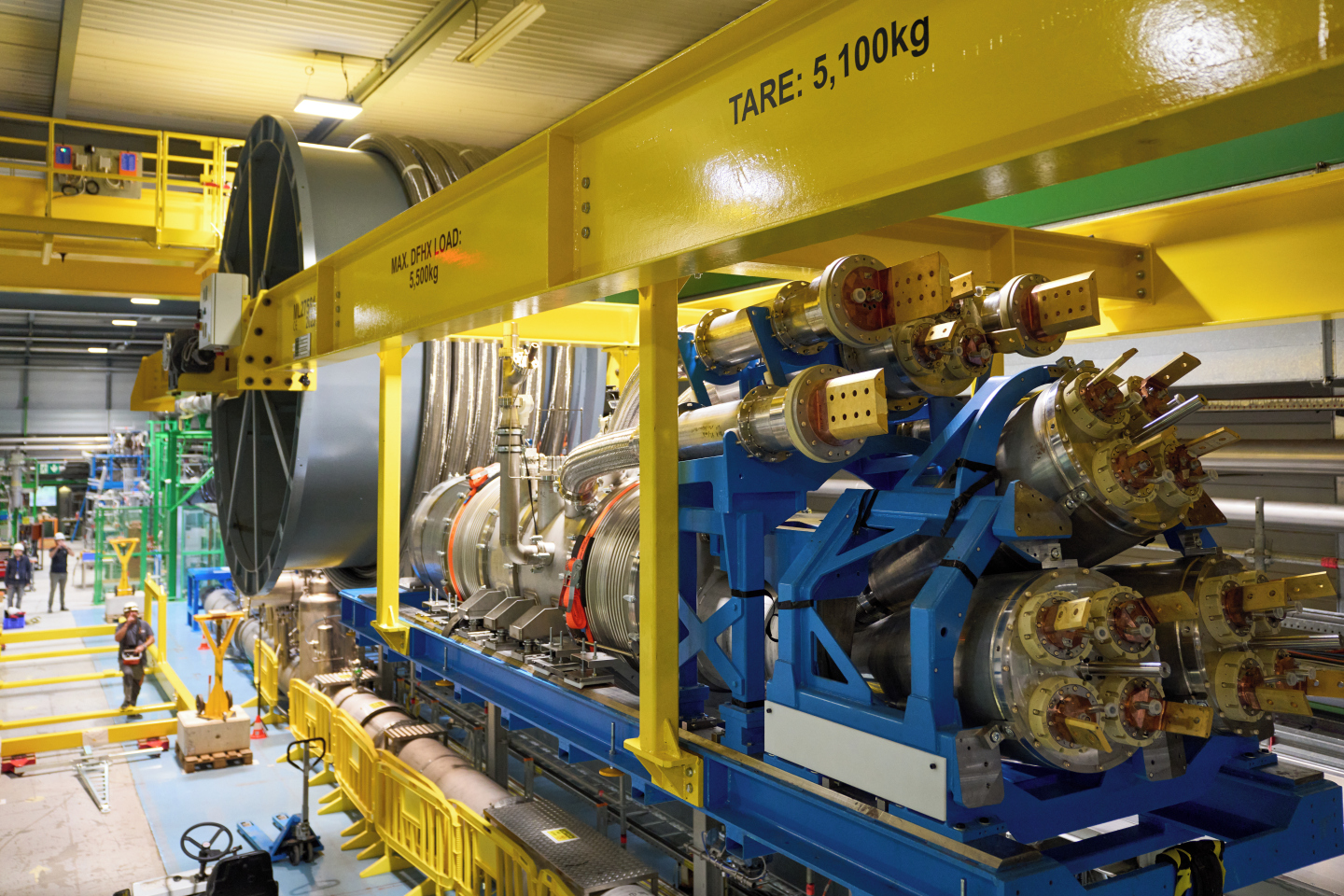
Two fully synchronised overhead cranes were used to handle the cold powering system, which is made up of a long transmission line and an impressive connection system. (Image : CERN)
An impressive operation recently took place in CERN's magnet test hall. The innovative cold powering system has been successfully installed in the High-Luminosity LHC (HL-LHC) Inner Triplet (IT) String test stand. This novel system comprises a long electrical transmission line, which has been specially developed to transport currents to the magnets across a wide range of temperatures. Its installation in the IT String follows on from the installation of the novel protection system and is an important milestone in the development of the HL-LHC.
The High Luminosity LHC (HL-LHC) is a major upgrade of CERN's Large Hadron Collider (LHC), which aims to increase the number of particle collisions (luminosity) and consequently boost the amount of physics data that can be collected, allowing further discoveries to be made.
Innovative beam-focusing magnets, known as inner triplets, are a major part of this upgrade. These magnets will be deployed on both sides of the beam interaction points at the ATLAS and CMS experiments with new powering, protection and alignment systems and - just like the LHC magnets - they will operate at 1.9 K (an extremely cold temperature, colder than deep outer space).
CERN is currently constructing a test string for the HL-LHC in the above-ground LHC test hall. It will be composed of the six main superconducting beam-focusing magnets - the inner triplets - and the associated technology, and the layout will reproduce the underground configuration of the LHC. After each system is individually validated, the IT String will be used to validate the integration of the full range of systems.
"The project will test superconducting magnet circuits under conditions as close as possible to those they will experience in the HL-LHC tunnel. The primary goal is to enable teams to optimise the installation of these components, plan for potential repair work or interventions in the tunnel and study the collective behaviour of major components", explains Marta Bajko, head of the IT String team.
The cold powering system transfers the current from the power converters to the magnets and is composed of a approximately 75 m-long high-temperature-based superconducting link made of novel superconducting materials (e.g. magnesium diboride). We say it is "high-temperature-based" because of its extraordinary ability to transport 120 kA of current, in a compact volume, from the 20 power converters - which sit in a new HL-LHC tunnel built specially for them and operate at room temperature - down to the magnets (which are kept at the extremely cold temperature of 1.9 K) in the LHC tunnel, with almost no energy loss.
"This milestone follows about ten years of development on different aspects of the cold powering system. Eight of these cold powering systems will be installed underground in the LHC after full qualification. The CERN transport team has been instrumental in this complex installation process," says Amalia Ballarino, leader of the HL-LHC cold powering system.

The handling of the cold powering system, weighing about 5 tonnes, required two fully synchronised overhead cranes and a whole team to manually move and adjust its position as it was wound onto, and then off of, a huge spool.
"Before carrying out the manoeuvre, we developed a complex integration and assembly procedure, conducting a risk analysis at each step. This involved meticulous studies and simulations and extensive real-life testing campaigns by the entire team", explains Stefanos Spathopoulos, the CERN engineer who was in charge of the design and production of key mechanical components and the planning of the operation.
These activities are paving the way for the next stages of the IT String, with the next major step being the installation of the magnets.






